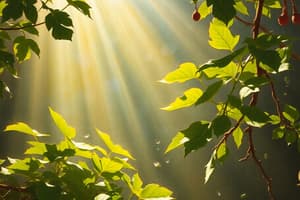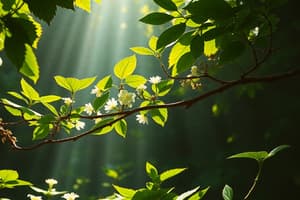Podcast
Questions and Answers
What is the primary function of pigments in photosynthesis?
What is the primary function of pigments in photosynthesis?
- To facilitate the movement of electrons to the stroma
- To absorb light energy, thus raising electrons to a higher energy state (correct)
- To convert water into oxygen as a byproduct
- To catalyze the formation of ATP during the Calvin cycle
Where does the light-dependent reaction of photosynthesis take place?
Where does the light-dependent reaction of photosynthesis take place?
- Outside of the chloroplast
- Within the thylakoid membranes (correct)
- In the stroma of the chloroplast
- In the inner membrane of the chloroplast
Which process directly utilizes light energy to produce ATP during photosynthesis?
Which process directly utilizes light energy to produce ATP during photosynthesis?
- Carbon Fixation
- Photo-phosphorylation (correct)
- The Calvin Cycle
- Electron Transport Chain in the Stroma
Which describes the stroma within a chloroplast?
Which describes the stroma within a chloroplast?
Which of these is a critical aspect for cell cycle regulation?
Which of these is a critical aspect for cell cycle regulation?
What is the primary function of the light-dependent reactions in photosynthesis?
What is the primary function of the light-dependent reactions in photosynthesis?
Where does the Calvin cycle take place within the chloroplast?
Where does the Calvin cycle take place within the chloroplast?
If cellular respiration and photosynthesis were compared, which statement would be true?
If cellular respiration and photosynthesis were compared, which statement would be true?
Which process involves the conversion of gaseous carbon into solid carbon?
Which process involves the conversion of gaseous carbon into solid carbon?
Which of the following best describes autotrophs?
Which of the following best describes autotrophs?
What role does water ($H_2O$) play in the light-dependent reactions of photosynthesis?
What role does water ($H_2O$) play in the light-dependent reactions of photosynthesis?
Which of the following is a waste product of the light-dependent reactions of photosynthesis?
Which of the following is a waste product of the light-dependent reactions of photosynthesis?
What is the role of chlorophyll in photosynthesis?
What is the role of chlorophyll in photosynthesis?
During photosynthesis, what is the immediate result of a pigment molecule absorbing a photon?
During photosynthesis, what is the immediate result of a pigment molecule absorbing a photon?
Which of the following best describes the relationship between the thylakoid membrane and the stroma in a chloroplast?
Which of the following best describes the relationship between the thylakoid membrane and the stroma in a chloroplast?
What is the key energy source for the phosphorylation of ADP to ATP during photophosphorylation?
What is the key energy source for the phosphorylation of ADP to ATP during photophosphorylation?
Which event is directly associated with the 'M Phase' within the context of the cell cycle?
Which event is directly associated with the 'M Phase' within the context of the cell cycle?
What would be the immediate consequence if a cell lost its ability to undergo apoptosis?
What would be the immediate consequence if a cell lost its ability to undergo apoptosis?
Which molecule is the final product of the Calvin cycle?
Which molecule is the final product of the Calvin cycle?
What is the main purpose of the ATP and NADPH produced during the light-dependent reactions?
What is the main purpose of the ATP and NADPH produced during the light-dependent reactions?
Which statement best describes the process of carbon fixation?
Which statement best describes the process of carbon fixation?
Which of these is not a direct input for the light-dependent reactions?
Which of these is not a direct input for the light-dependent reactions?
How does photosynthesis relate to cellular respiration regarding reactants and products?
How does photosynthesis relate to cellular respiration regarding reactants and products?
What term describes organisms that obtain energy by consuming other organisms?
What term describes organisms that obtain energy by consuming other organisms?
In what way are photosynthesis and cellular respiration different in terms of the molecules they build or break down?
In what way are photosynthesis and cellular respiration different in terms of the molecules they build or break down?
What does the initial splitting of water molecules during photosynthesis achieve?
What does the initial splitting of water molecules during photosynthesis achieve?
Flashcards
Photon
Photon
A packet of light energy.
Pigment
Pigment
Substances that absorb visible light. When pigments absorb visible light, electrons in the pigment molecule go to a higher energy state.
Thylakoid
Thylakoid
Membrane-bound compartments inside of chloroplasts. The thylakoid membrane is the site of the light-dependent reactions.
Stroma
Stroma
Signup and view all the flashcards
Photophosphorylation
Photophosphorylation
Signup and view all the flashcards
Photosynthesis
Photosynthesis
Signup and view all the flashcards
Carbon Fixation
Carbon Fixation
Signup and view all the flashcards
Light Dependent Reactions
Light Dependent Reactions
Signup and view all the flashcards
Light Independent Reactions (Calvin Cycle)
Light Independent Reactions (Calvin Cycle)
Signup and view all the flashcards
Chlorophyll
Chlorophyll
Signup and view all the flashcards
Heterotroph
Heterotroph
Signup and view all the flashcards
Autotroph
Autotroph
Signup and view all the flashcards
Comparison of Photosynthesis and Cellular Respiration
Comparison of Photosynthesis and Cellular Respiration
Signup and view all the flashcards
Reproduction
Reproduction
Signup and view all the flashcards
Cell Cycle
Cell Cycle
Signup and view all the flashcards
Mitosis
Mitosis
Signup and view all the flashcards
Meiosis
Meiosis
Signup and view all the flashcards
Cancer
Cancer
Signup and view all the flashcards
Chloroplast
Chloroplast
Signup and view all the flashcards
Study Notes
Photosynthesis
- Definition: Photosynthesis is a process used by plants and other organisms to convert light energy, typically from the sun, into chemical energy stored in carbohydrates.
- Carbon Fixation: The conversion of gaseous carbon dioxide into solid carbon during photosynthesis, occurring in the light-independent reactions (Calvin cycle).
- Equation: CO₂ + H₂O + photons → C₆H₁₂O₆ + O₂
- Light-Dependent Reactions:
- Occur in the thylakoid membrane of chloroplasts.
- Require light energy.
- The ultimate source of energy for all life comes from light energy from the sun.
- Require water (H₂O).
- Water is broken apart by photosystem II, providing electrons for the reaction to occur.
- Produce oxygen (O₂) as a waste product of breaking apart H₂O.
- Function: Produce ATP and NADPH for the light-independent reactions (Calvin cycle).
- Involve active and passive transport.
- Light-Independent Reactions (Calvin Cycle):
- Occur in the chloroplast stroma.
- Require ATP and NADPH produced in the light-dependent reaction.
- Require carbon dioxide (CO₂) from the atmosphere.
- Function: Ultimately produces glucose (C₆H₁₂O₆).
- Carbon fixation occurs during this stage.
Chloroplast Structure
- Chloroplast: A double-membrane organelle involved in photosynthesis.
- Thylakoid: Membrane-bound compartments within the chloroplast, site of light-dependent reactions. The thylakoid membrane is where light-dependent reactions occur.
- Stroma: Fluid-filled space surrounding the thylakoids, where the light-independent reactions (Calvin cycle) occur.
Photosynthesis vs. Cellular Respiration
- Reactants/Products: The reactants of cellular respiration are the products of photosynthesis and vice-versa.
- Energy Conversion: Photosynthesis converts light energy to chemical energy; cellular respiration converts one type of chemical energy into another type of chemical energy.
- Process Type: Cellular respiration is catabolic (breaks down larger molecules, like glucose), while photosynthesis is anabolic (builds larger molecules, like glucose).
- Catabolism/Anabolism Example: Cellular respiration breaks down a larger molecule (C₆H₁₂O₆) into smaller molecules (CO₂). Photosynthesis makes larger molecules (C₆H₁₂O₆) from smaller molecules (CO₂). Example: Photosynthesis is anabolic; Cellular Respiration is catabolic.
Definitions
- Heterotroph: "Other-feeders," organisms that obtain organic compounds from other organisms (consumers). Dependent on photoautotrophs directly or indirectly.
- Autotroph: "Self-feeders," organisms that produce their own organic compounds (producers). The ultimate source of all organic compounds for non-autotrophic organisms.
- Chlorophyll: A pigment in chloroplasts absorbing light energy. Found in photosystems.
- Photon: A packet of light energy.
- Pigment: A substance absorbing visible light; its electrons elevate to a high energy state when visible light is absorbed.
- Photophosphorylation: ADP's phosphorylation in photosynthesis to create ATP, using light energy to attach the phosphate group.
- Thylakoid: Membrane bound compartments inside chloroplasts.
Cell Cycle and Reproduction
- Cell Cycle Phases: G1, S, G2, M (mitosis) phases in the cell cycle.
- Mitosis Phases: Four phases characterizing mitosis and its outcome.
- Meiosis: Two stages (Meiosis I and Meiosis II) of meiosis.
- Cell Cycle Regulation: Checkpoints and proteins control the cell cycle.
- Cancer: Uncontrolled cell growth.
- Apoptosis: Programmed cell death.
- Cell Cycle Reproduction: Sexual and asexual reproduction occur within the cell cycle.
Studying That Suits You
Use AI to generate personalized quizzes and flashcards to suit your learning preferences.




